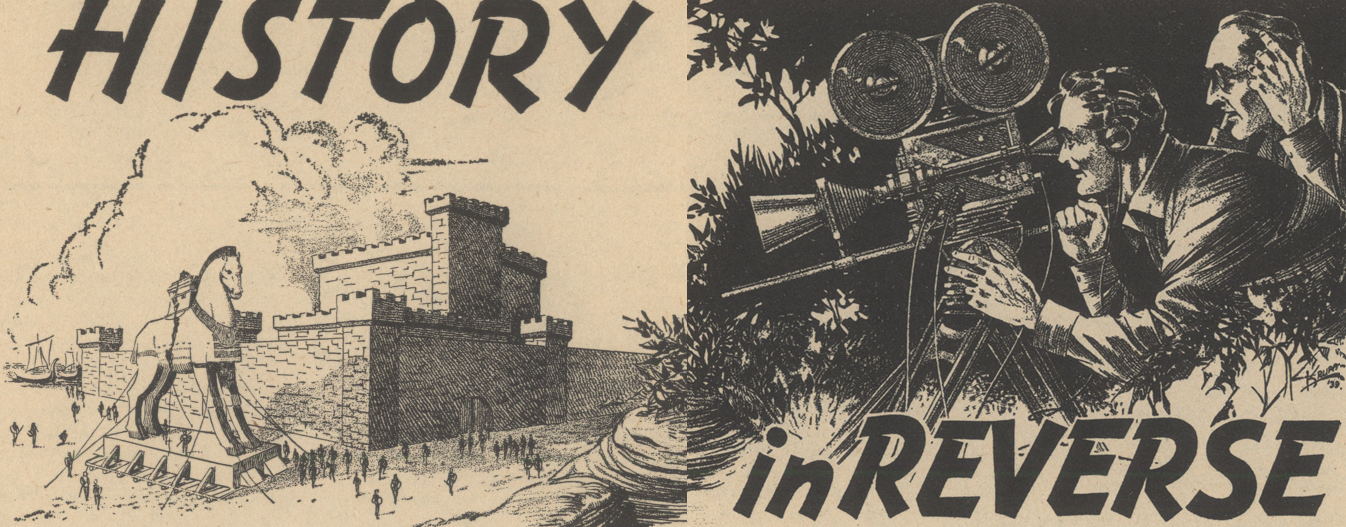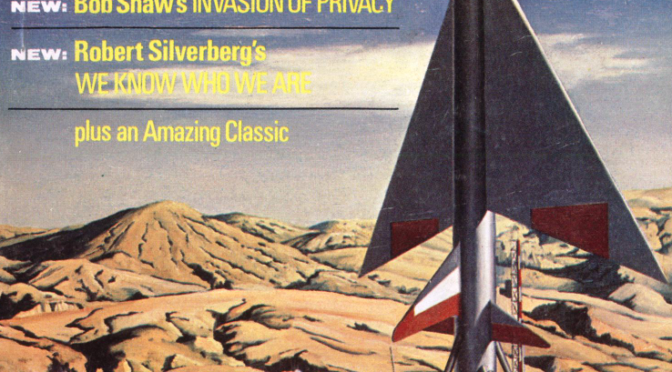
by John Boston
The July Amazing is fronted by John Pederson, Jr.’s second cover, an agreeable Martian-ish scene, reminiscent of nothing so much as . . . Johnny Bruck on a good day. So maybe the new commitment to domestic artists isn’t quite the boon I thought it was. We’ll see.

by John Pederson, Jr.
The non-fiction this month is a bit less gripping than usual. White’s editorial recounts his unsatisfactory encounter with a woman who wanted to write an article about SF fandom, but apparently never did (or it never got published). He then segues to a discussion of Dr. Frederic Wertham and his campaign against comic books which culminated in his book The Seduction of the Innocent. Then, finally, to the point: Wertham is now saying he too will write about SF fandom and White doesn’t think it will be any good. He’s probably right, but until we see what Wertham produces, discussing it is a little pointless.
The letter column remains contentious but is getting a little repetitive; at this point it’s hard for anyone to say anything new about New Wave vs. Old Farts, and no more inviting topic has emerged. The fanzine reviews are as usual, and the book reviews . . . are missing, damn it! To my taste they have been about the liveliest part of the magazine. I hope the lapse is momentary.
But speaking of SF fandom, I’ll take this lack of much to talk about as an occasion to mention something fairly striking about the magazine’s contents under Ted White’s editorship: there is an unusually large representation of Fans Turned Pro, authors who have—like White—been heavily involved in organized SF fandom. This issue features Bob Shaw, a leading light of Irish fandom and heavy contributor to the celebrated fanzines Slant and Hyphen, who later won two Hugo Awards as best fanwriter among other distinctions; he also had a story in the second (7/69) White-edited issue. Greg Benford (once a co-editor with White of the also-celebrated fanzine Void) has one of his co-authored “Science in Science Fiction” articles (the fifth) in this issue, and three stories to boot in White’s eight issues, as well as regular appearances in the book review column. Robert Silverberg, who published a slightly earlier well-known fanzine Spaceship, supplied an impressive serial novel and has a story in this issue. Terry Carr, another renowned fan editor, had a story in the last issue. Alexei Panshin is not to my knowledge a fan publisher but has won the Best Fan Writer Hugo for his prolific contributions to others’ fanzines. Harlan Ellison (short story in 9/69 issue) published the legendary Dimensions in the 1950s. Joe L. Hensley (same) is a member of First Fandom and published a fanzine in the 1940s.
And what does it all mean? The floor is open for sober analysis and wild speculation.
Orn (Part 1 of 2) , by Piers Anthony
The marquee item, or maybe the loss leader, in this issue is Piers Anthony’s serial Orn, “the epic sequel to Omnivore!” per the cover. Anthony’s novels have gotten mixed notices here and elsewhere, and Omnivore received from the Journey’s Brian Collins the ultimate damning with faint praise, or vice versa: “Anthony’s best novel to date; unfortunately it’s still not good.” The later Macroscope fared better.

by Michael William Kaluta
So we’ll see. Per my practice, I’ll withhold comment until the serial is complete. The blurb indicates that this one does not return to the interesting-sounding setting of Omnivore, but shuffles some of the characters off to yet another planet.
Invasion of Privacy, by Bob Shaw

by Michael Hinge
Bob Shaw’s novelette “Invasion of Privacy” is a little tour de force of rug-pulling. Protagonist George’s seven-year-old son says he saw his Granny Cummins, causing his fragile mother to flee in hysteria, since Granny—her beloved mother—died two weeks before. So where did little Sammy see her? At the local abandoned house, rumored of course to be haunted, he says. And when George sneaks over to take a look, we are embarked on a hokey and macabre body-snatchers melodrama, except that by the end it develops into something else entirely. I found this startlingly (if not amazingly) well done, especially compared to Shaw’s previous cartoonish contribution. Four stars, leaning higher. Tell me I’m crazy.
We Know Who We Are, by Robert Silverberg
Robert Silverberg’s short story “We Know Who We Are” is a routine if slightly strident variant on a familiar theme, the decadent survivors of a great civilization, told in an ostentatiously simple style with lots of capitalization. Protagonist Skagg is a resident of the Shining City, “in the middle of a plain of purple sand that stretches from the Lake of No Return to the River Without Fish.” This city shelters about six hundred people though there’s room for six hundred thousand. The Shiners (my term, not the author’s) are given to saying “We know who we are and what we want to be” when faced with uncertainty.

by Jeff Jones
Skagg is in the city’s outskirts, among the Empty Buildings where the Repair Machines no longer function, when he encounters Fa So La, a young woman from another city who is looking for the Knowing Machine. Skagg agrees to take her there, but warns that she won’t be able to approach it. They pass by the Mirror Walls and partake of a Drink Machine, but she declines the aid of a Riding Machine, and then they pass through a Cleansing Machine and are checked out by a Police Machine. Others appear and warn that the Knowing Machine will kill her, and a Soothing Machine and a Shelter Machine get cameos.
Fa So La goes in anyway, though Skagg is a Chicken, er, sorry, he’s afraid, despite Fa’s seductive overtures. He waits overnight, then enters the Zone of Peril, and after a while proceeds into the Zone of Impiety, and then enters the Knowing Machine itself. Gosh, I wouldn’t want to give away what happens there! So I’ll just say that after the climax and revelation, Skagg says he’s going to go visit some other cities and find out who he is and what he wants, and the others shudder and reiterate that they know who they are and what they want to be. Only the author’s manifest skill makes this smug morality tale a tolerable three stars. Or is this intended as a parody of certain counter-cultural tendencies? If so, too subtle.
History in Reverse, by Lee Laurence

by Julian S. Krupa
The Famous Amazing Classic this issue is “History in Reverse” by Lee Laurence (from Amazing, October 1939), the only appearance of that byline in the SF magazines. It purports to be the script of a suppressed radio program (“the incredible story CBS dared not broadcast,” says the blurb) reporting on the first showing of the movie “Outline of History,” for which they bought the rights from H.G. Wells. It provokes a panic. Why? Apparently, just because they’ve got what looks like contemporary footage of ancient history and prehistory. The story then flashes back to how this came about; not surprisingly, there’s a time machine. This is actually pretty lively for a while but it goes on too long and stalls out. Also it represents a considerable failure of imagination. I can just picture the young T.L. Sherred reading it and musing, “This guy really doesn’t think things through,” and then writing his magnum opus “E for Effort” some years later in response. Two stars.
Coloring the Sky, by Greg Benford and David Book
This issue’s “The Science in Science Fiction” article by Greg Benford and David Book is “Coloring the Sky,” which broadens the familiar question “Why is the sky blue?” to include “Why is the sunset green?” on an imaginary planet of Tau Ceti. The authors proceed briskly through a description of the visible spectrum, differential absorption by atmospheres, scattering of light, effect of dust and water vapor and of light traveling from low on the horizon (i.e. sunsets).
From there, they discuss the possibilities of other planets—different colors of starlight filtered through different kinds of atmospheres. And (back to Earth) volcanoes! Forest fires! Urban smog! The greenhouse effect! Oceanic absorption of carbon dioxide! Air pollution! (The authors note that “human technology in the last century has taken to burning coal, oil and wood at such a tremendous rate that the amount of carbon dioxide in the air has increased by a few percent. This has the effect of making the atmosphere a more efficient insulator, which would lead one to expect systematically warmer climates to arise.” Hey, that could be a problem.) Venus and its clouds and natural smog! Once more, the authors have done a fine job of covering a lot of material logically, succinctly and readably. To my taste these are about the best science articles in the SF magazines these days. Four stars.
Summing Up
By my criterion of last resort—asking for at least something unusually good, and nothing really stupid—this is a reasonably successful issue, with one quite good story and a very good article, an adequate Silverberg story and a reprint which is at least readable despite its faults. The serial, of course, looms as a mystery, to be unravelled next issue.
[New to the Journey? Read this for a brief introduction!]




Maybe the prevalence of fan-turned-pro writers is a case of who Ted knows. Between the bad blood generated by Sol Cohen not paying for reprints and the lousy pay rates, it may be that Ted has to rely on stories from friends from his acitfan days to fill out his pages. It's easier to wheedle and beg from someone you know well than from an old pro or a new writer you've never met.
"Orn" has been mostly interesting so far, though I'd put it somewhere between "Omnivore" and "Macroscope" in quality. It's got two threads, and one held my attention much more than the other. But there's a huge science problem with where it seems to be going.
"Invasion of Privacy" was a bit of a roller coaster ride. It started off all right, turned old hat, and then finished strongly in a very Bob Shaw way.
Silverberg's story was too allegorical for my tastes. I wouldn't be at all surprised if Jakobsson and Ferman both turned it down before Ted White saw it.
The reprint was very much of its day. Not the author's fault, but I kept comparing it unfavorably to Harry Harrison's "Technicolor Time Machine."
And the science article was very good. I'd say Benford and Book at their best are about on par with average Asimov, but their average is still far better than anything that appears in Analog.
DemetriosX: 'Silverberg's story … wouldn't be at all surprised if Jakobsson and Ferman both turned it down before Ted White saw it. '
I'd bet money on it, given how high Silverberg's star has risen currently, and rightly so, based on the quality of most of the work he's producing now.
Here on the other hand, what we have is only a testament to Silverberg's supreme professional competence, inasmuch as, if he wishes, he can even turn out a piece that's as supremely lackluster as any that 1950s-era Silverberg the Word Mill used to churn out.
"Supremely lackluster"—I like that…
~Gideon